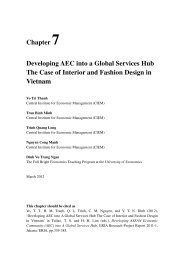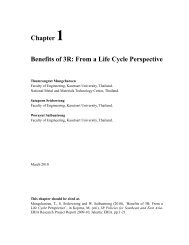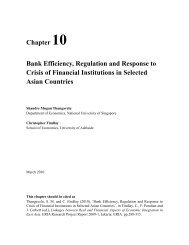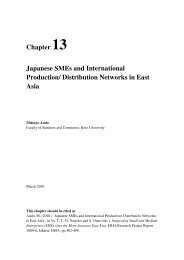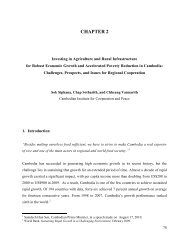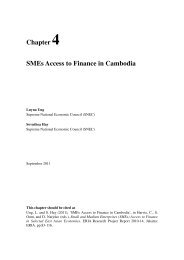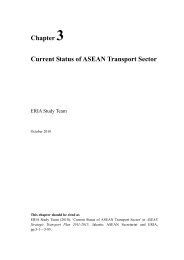Chapter 1 CAMBODIAN SMALL AND MEDIUM SIZED ... - ERIA
Chapter 1 CAMBODIAN SMALL AND MEDIUM SIZED ... - ERIA
Chapter 1 CAMBODIAN SMALL AND MEDIUM SIZED ... - ERIA
- No tags were found...
You also want an ePaper? Increase the reach of your titles
YUMPU automatically turns print PDFs into web optimized ePapers that Google loves.
While it is not unusual for a country with a small population to have so manysmall SMEs, this may indicate barriers to enterprise development. Traditionally, in awell functioning economy micro-enterprises develop into small enterprises, some ofwhich develop into medium sized and large enterprises. Few Cambodian companieshave developed in this fashion.On the other hand, there is evidence that much of the growth in SME numbers,discussed above is due to increases in numbers of small as opposed to micro enterprises.Data from the Ministry of Planning (MoP) shows that the number of firms employingbetween 10 and 49 workers as a percentage of all firms, increased from 39 to 79 percentbetween 1993 and 2001. During the same period the number of firms employing fewerthan 10 workers (micro enterprises) decreased as a percentage of all firms from 60 to 20percent. 20 The SME survey associated with this report supports these findings,providing evidence of a number of firms developing from micro to small to mediumsized enterprises.2.6 SME performanceWithin the manufacturing sector NIS data shows per worker output is almost alwayshigher for small firms than it is for large firms. 21 In the manufacture of food andbeverages gross output per worker is over twice as high for small as it is for largeenterprises (see Figure 2).However, Cambodian SMEs have low total factor and labour productivityrelative to neighbouring countries. By both measures, productivity of Cambodian firmslags behind enterprises in almost all other Asian nations. A 2004 World Bank (WB)study shows Cambodian firms to have total factor productivity 18 percentage pointsbelow those of India and 24 percentage points below those of China. Labourproductivity is 65 percentage points below that of India, and almost two thirds belowthat of China. 228




